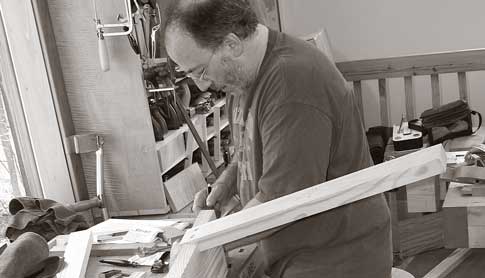
It’s 5 p.m. on Sunday, and almost all of the students in my “Precision Handsawing” class are packing up their tools to head home after two punishing days of listening to my drivel while trying to perfect their handsawing.
But in one corner of this picturesque Kentucky classroom, Michael Rogen refuses to stop laying out his half-lap joints. He refuses to lay down his tools and quit. Michael above all refuses to lay down, give up and wait to die.
Things are getting worse for Michael. His degenerative disease – its name is unimportant – has claimed most of his mobility, nearly all of his natural dexterity but absolutely none of his stubborn will to be able to saw, plane and chisel furniture-quality joints by hand.
These tasks are hard enough for a grown man in good physical condition – most of my students from this weekend are probably still recovering from sore feet and forearms. But when you add on the fact that Michael can barely stand without two canes and has virtually no grip in one of his hands, it makes you ashamed to be so dammed healthy and lazy in comparison.
I’ve known Michael – a former actor – for a few years now. He started asking my advice on buying some tools and bit by bit has worked his way into my life and the lifes of other woodworkers, tool makers and woodworking instructors.
Despite the advice of his doctors, Michael traveled to Indianapolis last year to take my “Introduction to Hand Tools” class at the Marc Adams School of Woodworking. He was in better shape then, but by the end of the week I couldn’t believe that the guy was on his two feet and pounding out mortise after mortise with a mallet and chisel.
As we parted last May, Michael said, “I think this is it. I think this is my last class.”
Hardly.
Michael went on to take a class in building a blanket chest at Kelly Mehler’s School of Woodworking. Then he took a class in making moulding planes from Larry Williams and Don McConnell followed directly by my class in sawing.
For the class, Michael took the bench next to mine, and while he had to have a little assistance with knifing a couple notches, he stubbornly declined other offers of help. He insisted on cutting his stock to rough length on a sawbench (I don’t know how he kept his balance), and he plowed through the project at a steady and slow pace.
At the end of the first day of this sawing class, I held a contest. I asked each student to make the best tenon he or she could manage with handsaws and a chisel. The tenon had to be consistent in its thickness and have clean shoulders.
Then all the students wrote their birthdate on their tenons and tossed them on my workbench. I left them there overnight so I was certain to forget whose tenon belongs to whom. On Sunday morning before class, I sorted through the joints, marked up their good points and bad and decided on a winner.
To everyone’s surprise (and delight) it was Michael’s tenon. For a piece of hand-cut work, it was solid. The tenon varied in its thickness by only a thousandth of an inch (or maybe two). The shoulders weren’t dead-nuts perfect, but they could be cleaned up with a shoulder plane easily and they outclassed many of the other tenons on my bench.
Michael (who lives in New York) was naturally suspicious that I had rigged the contest.
No so, my friend. You beat us all. Not only on that day, but in many other ways that have nothing to do with cheeks and shoulders, or tools and joinery.
— Christopher Schwarz